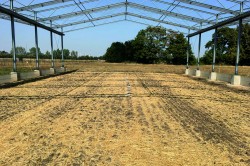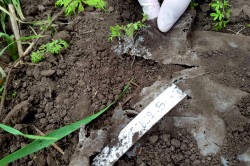Press Release, 13. September 2021
Degradation of biobased plastics in the soil
Microbial community defies climate change
The idea of biodegradable plastics sounds good at first. However, very little is known about how they are degraded in the soil and how this is influenced by climate change. In two recent studies, soil ecologists at the Helmholtz Centre for Environmental Research (UFZ) have shown which microbial community is responsible for degradation, what role the climate plays in this process, and why biodegradable plastics could still be problematic.

Photo: Purahong / UFZ

Photo: Purahong / UFZ
Plastic that ends up in soils, oceans, or inland waters can harm the organisms living there and lead to serious and long-term disruptions in the ecosystems. The development and increased use of biodegradable plastics is therefore the focus of a more ecological economy. "But despite the positive image of biodegradable plastics, we still know very little about how they act in the soil or how they are degraded", says Prof. François Buscot, soil ecologist at the UFZ.
In order to shed more light on this, Buscot’s research team investigated the following questions in a recent study published in Environmental Science and Technology: How quickly does biodegradable plastic degrade? Which micro-organisms are involved? How do they interact? Which conditions promote the degradation process? And which inhibit it? "We also wanted to know how the changing temperatures and precipitation levels resulting from climate change affect the degradability of the plastics", explains Dr Witoon Purahong, also a soil ecologist at the UFZ and lead author of the study.
To this end, experiments were conducted at the Global Change Experimental Facility (GCEF) in Bad Lauchstädt, which is currently considered as one of the world’s largest outdoor climate experiment in terms of area. The researchers investigated the consequences of climate change on land use and ecosystems. The focus was on mulch and horticultural films, which are used to cover the soil. These are typically made of polyethylene (PE), a plastic produced from fossil raw materials. For technological reasons, residues of the films often remain in the soil. This leads to contamination with microplastics in the medium term. Switching to biodegradable alternatives would therefore make a lot of sense here. But are there side effects of using such alternatives?
In order to find out, the team investigated how polybutylene succinate-co-adipate (PBSA), a bio-based mulch film partly produced from plants (corn, sugarcane, cassava), biodegrades under the natural conditions of an agricultural field. The researchers distinguished between today’s climate conditions and simulated climate conditions as projected for Germany around 2070. They used modern molecular biology methods (next generation sequencing) to determine which microbial community had colonised on the plastic itself as well as in the surrounding soil.
"We were able to show that after just under a year, around 30% of the PBSA had already degraded. This is quite a lot under the climatic conditions that currently prevail in Germany", says Purahong. "The main actors are fungi, which are supported by a diverse bacterial community and several other micro-organisms. These include bacteria that supply the fungi with nitrogen (which is rare in plastic) or bacteria and archaea that utilise toxic degradation products. "An intelligent degradation and recycling community is forming on and around the plastic - even with a similar degradation rate under the simulated future climate conditions, adds Purahong. The changed climate apparently does not harm the PBSA-degrading fungi. The microbial community around them is slightly different - but the degradation result is similar. "We hadn’t expected such good news".
In another study published in Environmental Science Europe, the UFZ researchers examined the community of micro-organisms under more stringent conditions. They investigated how the community changes when large amounts of PBSA enter the soil as well as what happens when high concentration of nitrogenous fertiliser is applied. "Large amounts of PBSA actually make the microbial community in the soil quite different", says doctoral candidate Benjawan Tanunchai and lead author of the study. With a 6% increase of PBSA in the soil, the diversity of fungal species decreased by 45% and that of archaea by 13%. On the other hand, the high load of PBSA in combination with the fertilisation of the area led to the proliferation of Fusarium solani, a widespread plant-damaging fungus.
The two UFZ studies thus yield one piece of good news and one piece of not-so-good news: PBSA in the soil can be degraded comparatively quickly and efficiently - even under future climate conditions. However, if PBSA is present in large quantities together with high concentrations of nitrogenous fertiliser, PBSA degradation can have a negative impact on agricultural production as a result of a disturbed microbial community and the increased presence of pests.
"When large amounts of plastic end up in the environment, it is never good - even if it is a biodegradable plastic", says Buscot. "The best thing would be to avoid plastic altogether. However, because this is currently an unrealistic goal, we should at least rely on biodegradable plastics everywhere possible and know as much as possible in advance about their degradation properties and consequences."
Publications:
Witoon Purahong, Sara Fareed Mohamed Wahdan, Daniel Heinz, Katalee Jariyavidyanont, Chanita Sungkapreecha, Benjawan Tanunchai, Chakriya Sansupa, Dolaya Sadubsarn, Razan Alaneed, Anna Heintz-Buschart, Martin Schädler, Andreas Geissler, Joerg Kressler, and Franc?ois Buscot: Back to the Future: Decomposability of a Biobased and Biodegradable Plastic in Field Soil Environments and Its Microbiome under Ambient and Future Climates, ACS Environmental Science & Technology, (2021) https://doi.org/10.1021/acs.est.1c02695
Tanunchai, B., Juncheed, K., Wahdan, S.F.M. et al. Analysis of microbial populations in plastic-soil systems after exposure to high poly(butylene succinate-co-adipate) load using high-resolution molecular technique. Environ Sci Eur 33, 105 (2021). https://doi.org/10.1186/s12302-021-00528-5
Further information
Prof. Dr. François Buscot
Head of UFZ Department Soil Ecology
francois.buscot@ufz.de
Dr. Witoon Purahong
UFZ Department Soil Ecology
witoon.purahong@ufz.de
UFZ press office
Susanne Hufe
Phone: +49 341 6025-1630
presse@ufz.de
In the Helmholtz Centre for Environmental Research (UFZ), scientists conduct research into the causes and consequences of far-reaching environmental changes. Their areas of study cover water resources, ecosystems of the future, environmental technologies and biotechnologies, the effects of chemicals in the environment, modelling and social-scientific issues. The UFZ employs more than 1,100 staff at its sites in Leipzig, Halle and Magdeburg. It is funded by the Federal Government, Saxony and Saxony-Anhalt.
www.ufz.deThe Helmholtz Association contributes to solving major challenges facing society, science and the economy with top scientific achievements in six research fields: Energy; Earth and Environment; Health; Key Technologies; Matter; and Aeronautics, Space and Transport. With some 39,000 employees in 19 research centres, the Helmholtz Association is Germany’s largest scientific organisation.
www.helmholtz.de